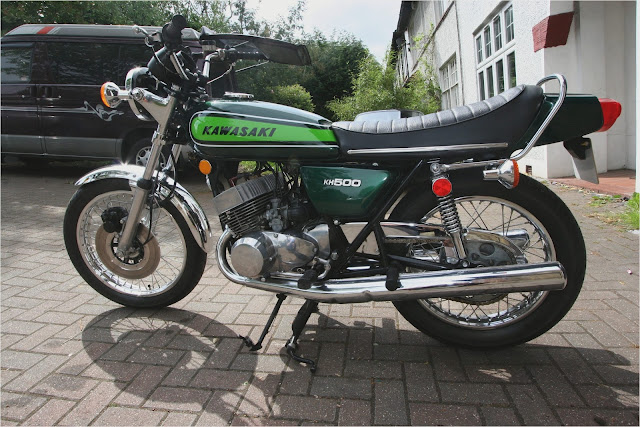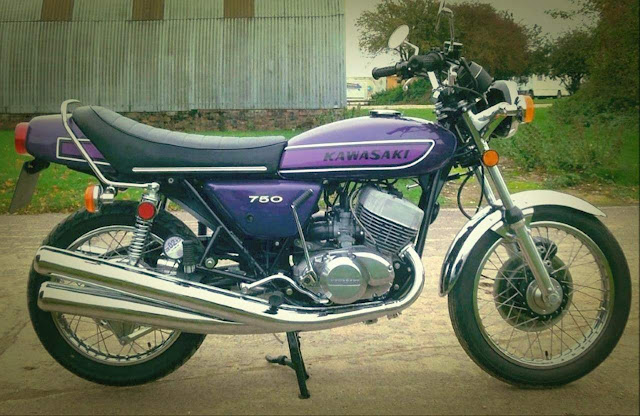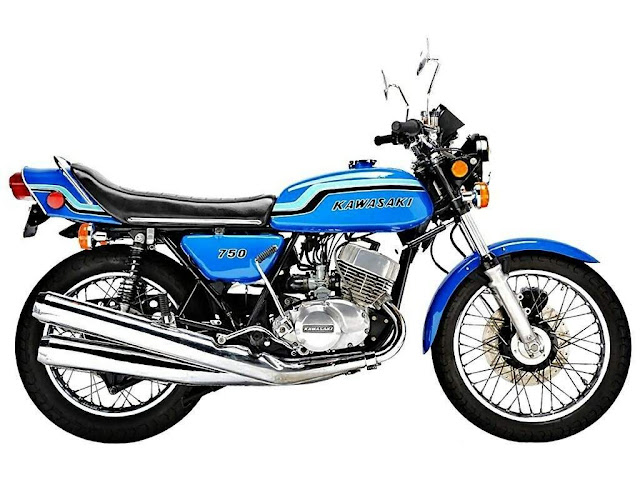Kawasaki H2 750
Kawasaki’s 748cc two-stroke engine kicked out 74hhp and had more mid-range torque than its 500cc HI predecessor. Hydraulic steering damper was a worthwhile addition.
Lean, simple styling gave little clue to the H2’s fearsome performance.
High handlebars were a hindrance at high speed but no handicap to the Kawasaki's reputation as an unbeatable sprinter away from the traffic lights.
For sheer excitement, there was nothing gfiSS* on two wheels to match the 750 H2 two- stroke triple that Kawasaki unleashed in 1972. Fast, loud, smoky, thirsty and ill-handling, the bike that was also known as the Mach IV was a wild ride that quickly earned a reputation for unmatched speed and aggression. ‘It’s so quick it demands the razor-sharp reactions of an experienced rider,’ bragged Kawasaki’s publicity material, and few who rode the triple disagreed.
The basis of the H2 was Kawasaki’s first three- cylinder two-stroke, the 500cc HI (or Mach III), which had been launched in 1969. This too was a fast and fiery machine that became popular, especially with American riders who valued acceleration from a standing start above all else. This group, labelled ‘stoplight-to-stoplight freaks’ by one magazine, was even better served by the larger model, whose 748cc air-cooled engine had a peak output of 74bhp at 6800rpm.
That was not only 14bhp up on the smaller triple, but also put rivals such as Suzuki’s liquid- cooled GT750 triple and Honda’s CB750 four in the shade. Physically the new model closely resembled the Mach III, with fairly high and wide handlebars and fuel tank that was narrow despite the compact three-cylinder engine’s thirst. The chassis layout of twin-downtube frame, twin rear shocks and slim forks holding a 19-inch front wheel and single brake disc also matched that of the smaller machine.
Searing acceleration
As well as its extra capacity the H2 had milder porting and ignition timing, which helped give a usefully broad spread of power. But although that meant the triple could be ridden gently, with minimal use of its five-speed gearbox, that was not what this bike was built for. Sheer speed was its forte, not so much the maximum of about 120mph (193km/h) as the searing acceleration that enabled it to reach over 1 OOmph (161km/h) from a standing start in less than 13 seconds, and to leave the line in a cloud of smoke with its front wheel in the air.
Chassis performance was less impressive, as the triple’s blend of power, light weight and barely adequate frame and suspension could provoke what one report described as a 'deadly wobble’. Owners were well advised to supplement the standard friction steering damper with an optional hydraulic damper, for which a frame lug was provided. At least the single front disc brake was reasonably powerful, although many riders boosted the system by fitting an optional second disc.
Original Triple: the H1 500
Kawasaki's first mean and nasty two-stroke was the 500cc H1, also known as the Mach III, which was introduced in 1969 and did much to establish the firm's reputation for performance. The triple produced 60bhp at 7500rpm, was good for over 115mph (185km/h) and was a match for anything on wheels away from the line due to its spectacular power-to-weight ratio. It combined the H2's dubious handling and poor fuel economy with a narrow power band that made it even more demanding to ride. New Zealander Ginger Molloy rode the racing derivative, the H1R, to second place in the 500cc world championship in 1970.
Conventional styling and a broad dual seat with grab-rail did not hide the fact that this was a scary bike by early 1970s standards. The single front brake disc gave reasonable stopping but twin-disc conversion was a popular modification. So was swapping the standard exhaust system for a set of expansion chambers, for extra power, noise and possibly holed pistons.
Plenty of riders were happy to accept the triple’s handling and thirst because it was competitively priced and, most of all, so fast. ‘The Mach IV rates as the ultimate stud bike now available in terms of raw power and sheer speed,’ concluded American magazine Cycle World. ‘If being the fastest on your block appeals to you, so will the Mach IV!’ Although tightening emissions legislation meant that the triple was first detuned, then dropped, it would not be forgotten.
Kawasaki H2 750 Specification
- Engine Air-cooled two-stroke triple
- Capacity 748cc (71 x 63mm)
- Maximum power 74bhp @ 6800rpm
- Transmission Five-speed, chain final drive
- Frame Steel twin downtube
- Suspension Telescopic front; twin shocks rear
- Brakes Disc front; drum rear
- Weight 454lb (206kg)
- Top speed 120mph (193km/h)



















0 comments: